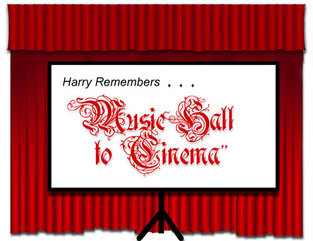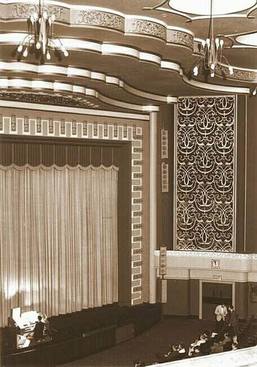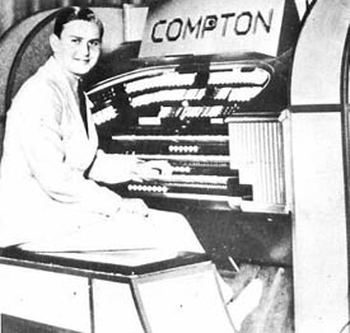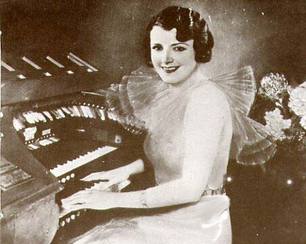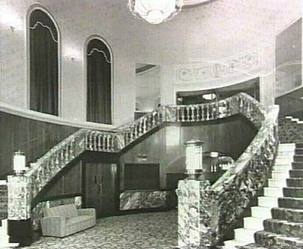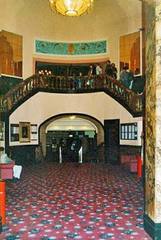Harry Remembers Part 2
David Bridgeman-Sutton continues his conversations with Harry, recalling halcyon days as cinema organist.
**See postscript
**
From Fleapit to Palace
|
"The first organ I played in a cinema", Harry recalled, "was a typical 2-manual church instrument of about 14 speaking stops, bought second hand at knock-down price by the theatre-owner."
"By that time programmes were becoming longer and orchestras just couldn’t cope with two or three houses, each of two hours or more. Theatre owners felt that an organist could, so several looked round for a second-hand church organ. Like most others, mine had tracker action, but I was luckier than some players; the stop action was pneumatic and there were three or four pistons to each manual. |
|
“The cinema, like most at that time, was a converted variety theatre. The organ was in one of the boxes and a system of mirrors rigged up so the player could watch the show and extemporise an accompaniment. We added a few simple sound effects - electric bell, bulb motor-horn and even a set of tubular bells. Then someone came up with a device that produced single shots and fusillades from the caps used in toy pistols.
"We stood that on a drum to act as an amplifier and “fired” by pulling strings. In the excitement, we sometimes pulled the whole contraption over and it had been known to roll out of the box and along the auditorium, making extraordinary noises on the way. This was easily the most popular effect we produced! |
“Playing that tracker organ for a long show - often with right hand and pedals only as the left hand operated the effects department - was hard work. Although I was young, I went to bed afterwards feeling more tired than I have ever felt since. The Hope-Jones style theatre organs in the new Picture Palaces took us into a different world - providing light touch, a straight-ahead view of the screen and a range of percussion and sound effects easily operated by toe-pistons.
|
“The organs - and the people who played them - were generally looked down on by the musical Establishment of the day. This was quite unfair as technically and musically many theatre organists were, at least, the equal of others. It made recruiting players difficult, however, and many church organists gave exaggerated shudders whenever the local Compton or Wurlitzer was mentioned.
"Not all did so; Norman Cocker, organist of Manchester Cathedral and composer of the well-known Tuba Tune set an example by playing regularly at local cinemas. His was a well-known figure, dashing between cathedral and cinema. As often as not he was wearing carpet slippers. |
|
“Those who suffered most from the musical snobbery were women cinema pianists. Music teaching was one of the few professions accessible to women then. It was one thing to play a piano - a respectable instrument - in a darkened orchestra pit and quite another to sit in the limelight playing a cinema organ! As teachers in private practice, they had to consider the possible effect on parents of prospective pupils and many decided the risk to what had been their main source of income was too great.
"A few made the changeover, of course and enjoyed a rarity value. Florence de Jong was probably the youngest of these - she was appointed at sixteen and is still active at 60* |
“Many of us were young, and were given first appointments at seventeen or eighteen. A number of ex-cathedral choristers took to this new career that had opened up. With organs installed more rapidly that organists could be recruited, it became a very well-paid occupation. While I was still in my twenties I obtained my pilot’s licence and bought my own ‘plane - and that took some money, even then.
“A major regret is that the slow travel of the era made concert touring impracticable for all except the great names - Jesse Crawford and Fats Waller from the USA, for instance. During one summer season, spent at a theatre in a town with ferry services to Germany and Holland, a Dutch organist and I exchanged consoles for a couple of days each week - his was a delightful Standaart instrument. For most, such changes were impossible.
“They were good years, and we hoped that they’d last for ever."
David Bridgeman-Sutton,
June 1, 2006
June 1, 2006
Photo thanks:
Pic 2: Publicity photograph - thanks to Wayne Ivany.
For pics 4 - 6, thanks to Irena Porter: www.images-of-london.co.uk
Pic 2: Publicity photograph - thanks to Wayne Ivany.
For pics 4 - 6, thanks to Irena Porter: www.images-of-london.co.uk
* This conversation took place fifty years ago. Miss de Jong later became Musical Director of the National Film Theatre and died in 1990 at the age of 96.
** Postcript:
Peter Hammond (https://www.ssfweb.co.uk/abc-organ/) points out that memory plays tricks. The State cinema Kilburn, although the largest in Europe, could never claim to be the largest in the world; it was exceeded by several in the US. The State had seating for 4,010 patrons and while standing at the back was allowed, this was always limited to small numbers.
Thank you, Peter!
** Postcript:
Peter Hammond (https://www.ssfweb.co.uk/abc-organ/) points out that memory plays tricks. The State cinema Kilburn, although the largest in Europe, could never claim to be the largest in the world; it was exceeded by several in the US. The State had seating for 4,010 patrons and while standing at the back was allowed, this was always limited to small numbers.
Thank you, Peter!

